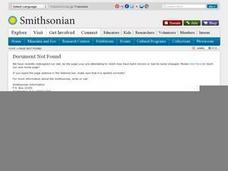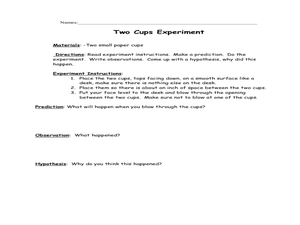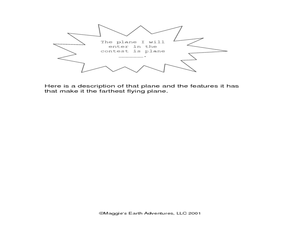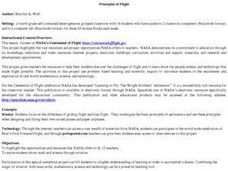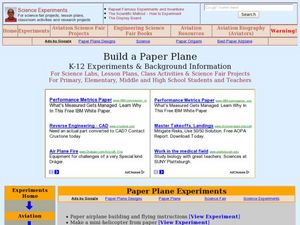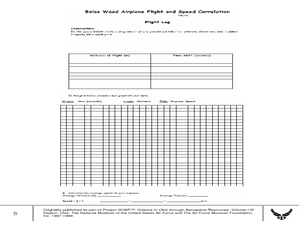Curated OER
Women In Aviation
In this aviation instructional activity, students take an electronic field trip to the Aviation Museum of Kentucjy. In the process the instructional activity looks at women in aviation history. The focus is upon how they could be...
Curated OER
Flight Home Lesson Plan 3
Students examine photographs of twentieth-century aircraft from the National Air and Space Museum. They compare aircraft wings, fuselages, and engines to investigate different approaches to aircraft design.
Curated OER
Flight Home
Students experiment to investigate the role in fixed-wing flight. They watch as air and water flow around surfaces to examine the dynamics of airflow around an aircraft wing.
Curated OER
Nazis Flying Saucers – Film Sparks UFO Debate
Students explore the aircraft used in World War II. In this World History lesson, students read an article that describes a "flying saucer" created by the Nazi's. Upon completion of the reading, students answer questions on the article,...
Curated OER
Understanding Bernoulli's Principle
Fifth graders explain why we fly. In this space science activity, 5th graders discuss Bernoulli's prinicple and its relation to flight.
Curated OER
Pilots
Young scholars read books, learn about the letter p, and have 'p' snacks all to learn about pilots. Students also pretend to fly and draw what they would see if they were flying up in the air.
Curated OER
The Aerial Age
Students infer America's attitude towards aviation in the early 1900s. In this The Aerial Age lesson, students analyze early 1900s literature, music, advertisements, and popular culture in reference to aviation. Students represent their...
Curated OER
Lady of the Sky Amelia Earhart
Eighth graders explore the contributions of Amelia Earhart. In this Amelia Earhart lesson, 8th graders research Internet and print sources to find information about the aviation feats of Amelia Earhart. Students write summaries based on...
Curated OER
Help Maggie Rebuild Her Airplane!
In this airplane worksheet, students build airplanes out of paper and test their accuracy while flying them. Students build 6 planes and fill out test logs to go with them.
Curated OER
Dayna Lykins, Leanna Prater
Fourth graders compare and contrast gliding flight and true flight. They investigate the basic principles of aeronautics. The class participates in activities to observe lift and the effect of air. Students design and fly their own...
Curated OER
Lifting Bodies: Designing Your Own Spacecraft
Students work cooperatively with classmates to design a wingless vehicle that can fly back to Earth from space, landing like an aircraft. Students plan and describe their models. Also, they will research facts about the lifting body...
Curated OER
Turbojet Thrust
Students, after reading the Web page Turbojet Thrust and completing the activity, explain how jet engines use air to produce thrust. The educational software ""FoilSim" is used in this lesson to help students calculate thrust.
Curated OER
Center of Gravity Problem Set
Pupils read a NASA Web-based text, then demonstrate an understanding of the text by using it to complete an activity on the center of gravity of a commercial cargo airplane.
Curated OER
Build a Paper Plane
Students study the history of the paper plane. In this design instructional activity students create several types of paper planes and determine if there is a difference in mean flight distances.
Curated OER
Maximum Flight Time
Students, after reading an explanation from a NASA Web site, demonstrate an understanding of the text by applying it to questions involving Maximum Flight Time and Range under varying conditions.
Curated OER
Things That Fly
Students locate images of two things that fly on the Internet and print them. They develop graphic organizers to compare and contrast the two images and exhibit the images along with the organizers in a classroom gallery.
Curated OER
Altitude and Flight Forces
Students use the World Wide Web to access and use FoilSim. They also use the World Wide Web to access the NASA Glenn Web site for information relative to the factors involved with the flight of an airplane.
Kenan Fellows
Weight and Balance of an Airplane
A career in aeronautics might be calling your class members. Building from the previous two lessons in the series, learners continue analyzing the mathematics of aeronautics. Groups create a paper airplane using paperclips for balance....
Curated OER
Flying with Fractions
Learners test their knowledge of the Wright Brothers and their aircraft, and compute ratio of two numbers to determine the ratio between wing span and length of aircraft.
Curated OER
Migration Activation
Young scholars play the role of migrating birds. As a class, they simulate a migration of birds to one place and back again. They relate their habitat size and changes to their current population numbers. They discover the many dangers...
Curated OER
Balsa Wood Airplane Flight and Speed Correlation
Ninth graders calculate the average speed of their balsa wood airplane. For this physics lesson, 9th graders build their own airplane and make necessary modifications to to make it fly straight. They interpret distance and time graph...
Curated OER
Airplane Design
Students design an airplane. In this transportation instructional activity, students review the parts of an airplane and their functions. Students work in groups to design their own airplane, reflect on the ideal plane, and compare it to...
Curated OER
Wright Brothers Centennial: Impact of Technological Advance
Eighth graders examine the impact of powered flight on the North Carolina coast. After reading news articles, they explain how the first flight affected community pride. They develop a hypothesis about the long-term economic impacts to...
Curated OER
Paperplane Flying Circus
Students create paper airplanes. They compare and contrast the airplanes created in class and test them out. They adjust their airplanes until they all fly. They discuss the forces that allow flight to occur.




